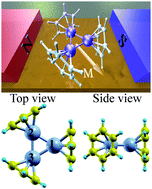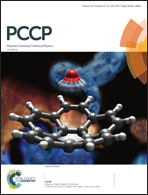Complex magnetic orders in small cobalt–benzene molecules†
Abstract
Organometallic clusters based on transition metal atoms are interesting because of their possible applications in spintronics and quantum information processing. In addition to the enhanced magnetism at the nanoscale, the organic ligands may provide a natural shield against unwanted magnetic interactions with the matrices required for applications. Here we show that the organic ligands may lead to non-collinear magnetic order as well as the expected quenching of the magnetic moments. We use different density functional theory (DFT) methods to study the experimentally relevant three cobalt atoms surrounded by benzene rings (Co3Bz3). We found that the benzene rings induce a ground state with non-collinear magnetization, with the magnetic moments localized on the cobalt centers and lying on the plane formed by the three cobalt atoms. We further analyze the magnetism of such a cluster using an anisotropic Heisenberg model where the involved parameters are obtained by a comparison with the DFT results. These results may also explain the recent observation of the null magnetic moment of Co3Bz3+. Moreover, we propose an additional experimental verification based on electron paramagnetic resonance.



 Please wait while we load your content...
Please wait while we load your content...